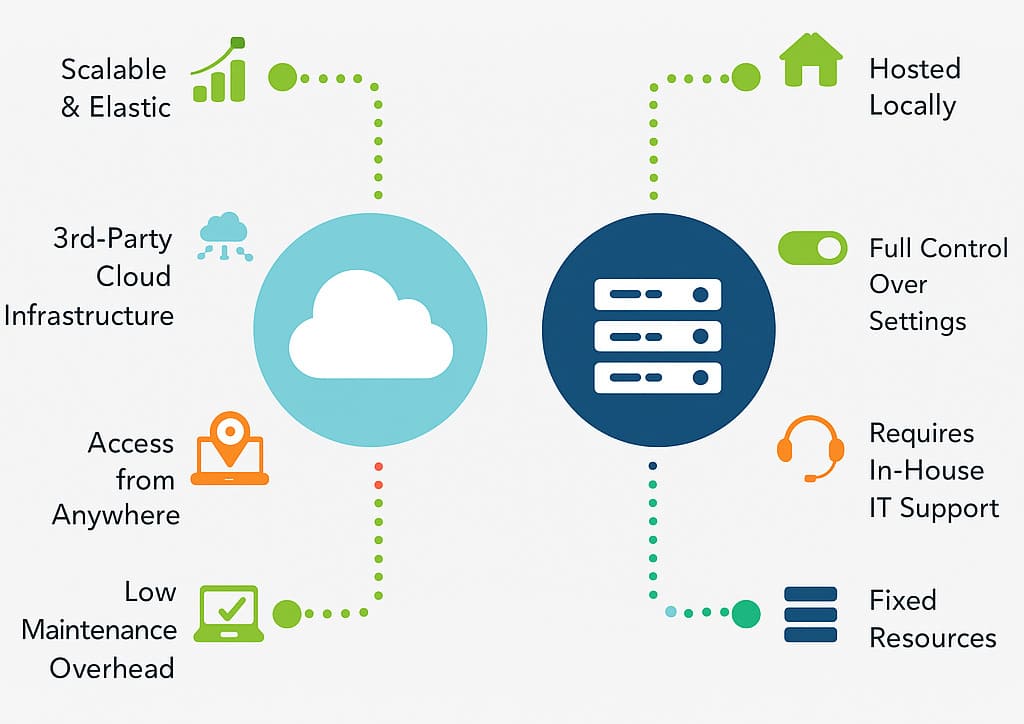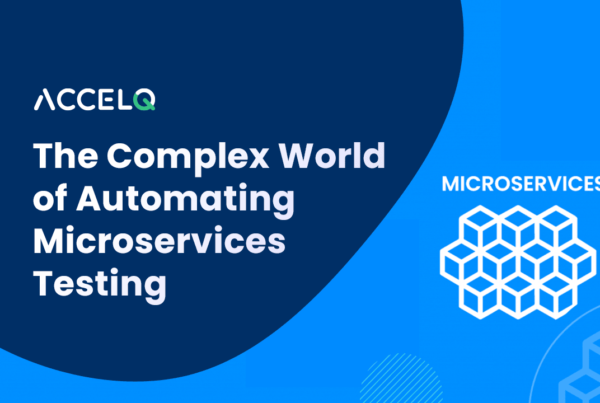Cloud-Based vs. On-Premise Test Automation: What to Choose in 2025?

Test automation has become critical to delivering rapid software releases as businesses change their digital operations. QA specialist still has to make a big decision: should your test infrastructure be on-premises or in the cloud? Speed, scalability, and safety are critical factors in the debate of cloud vs. on-premise test automation, besides the location of your tests.
What is the Difference Between Cloud-Based and On-Premise Test Automation?
Gaining a clear understanding of the fundamental differences between cloud vs. on-premise test automation is critical before selecting a tool or designing your testing framework.

Cloud-Based Automation Testing
Test implementation, reporting, and environment management are carried out in this approach on cloud servers, which are usually employed by 3rd-party platforms. Through the internet, you may access environments, tools, and gadgets without having to own or manage physical infrastructure.
Key traits:
- Scalable & elastic
- Hosted on 3rd-party cloud-assisted infrastructure.
- Access from anyplace.
- Lower configuration & maintenance overhead.
On-Premise Automation Testing
In this case, your own infrastructure or data center houses the comprehensive test stack, which encompasses the necessary tools and test environments. Though you have complete control over your test procedures, there are security, hardware, and scalability obligations as well.
Key traits:
- Locally hosted within the company.
- Fixed resource convenience.
- Great control over test settings.
- Demands in-house IT assistance & infrastructure.
When contrasting cloud vs on-prem test tools, the option often comes down to striking a balance. When comparing cloud vs on-prem test tools, the decision typically comes down to balancing scalability, performance, and security with the level of control and customization an organization requires.
Pros and Cons of Each Method
Cloud-Based Automation Testing
Pros:
- Accessibility: Execute tests from anywhere, perfect for distributed teams.
- Speed to Deploy: No configuration or hardware installation.
- Scalability: Scale test environments as needed (perfect for CI/CD and parallel tests).
- Lower Upfront Expenses: Subscription or pay-as-you-go rating.
- Automatic Updates: Obtain the new traits and patches without human effort.
Cons:
- Internet Dependency: Necessitates the highest-speed & stable internet.
- Data Security Worries: Complex verticals (such as healthcare or finance) might have regulatory limitations.
- Restricted Customization: A few cloud solution providers limit customers’ access to intricate connections or customizations.
On-Premise Automation Testing
Pros:
- High Control: Complete access to software, hardware, and environment settings.
- Perfect Information Secrecy: Appropriate for enterprises with stringent information residency or compliance necessities.
- Customization: Adapt the configuration to legacy or complicated systems.
Cons:
- High upfront charges: Licenses, maintenance, servers, and qualified workers.
- Inadequate Adaptability: Infrastructure expansion can be expensive and time-consuming.
- Extended Configuration & Maintenance: Additional IT engagement and slow deployment.
Which Is Better: Cloud or On-Premise Testing?
The decision to implement on-premise vs cloud-based QA chiefly depends on a company’s unique needs and operational priorities. Let us find out a breakdown of which is better for enterprise testing in 2025: cloud or on-prem test automation?
When Cloud Testing Works Best:
Distributed & Remote Teams
- Access environments & tools from anywhere.
- Ideal for international DevOps or QA teams.
Scalability & Speed
- Spin up test settings (devices, OS, & browsers).
- Suitable for CI/CD pipelines and parallel test execution.
Lower Initial Expenses
- The pay-as-you-go model decreases capital expenditures.
- There is no requirement to expense money on infrastructure or servers.
Auto Updates & Maintenance-Free
- Cloud-based platform manages updates, scalability, and security.
When On-Premise Testing Works Best:
High Security & Compliance
- Crucial for verticals such as healthcare, finance, or government.
- Total control over frameworks for data, access, and compliance.
Customized Legacy Systems or Configuration
- If your apps demand specific test setups or are tied to legacy environments.
Offline Ability
- Test environments are not dependent on net access or exterior services.
The majority of organizations in 2025 are moving toward a hybrid automation model, using the strengths of both cloud and on-premise solutions, which boosts overall productivity.
Hybrid Approach: Best of Both Worlds?
Hybrid automation is considered the preferred choice for businesses demanding to balance agility with control. A hybrid test automation solution blends the customization and security of on-premise settings with the accessibility of cloud-assisted solutions.
Why Select Hybrid Cloud Test Automation?
- Resilience & Flexibility: Tests can still be conducted on the backup platform (local or cloud if one environment fails.
- Scalability with Control: Keep backend or performance testing in-house and offload cross-browser or regression testing to the cloud.
- Optimized Expenses: Utilize cloud-assisted resources on demand, reducing infrastructure investment while handling protected local assets.
- Smooth CI/CD Pipeline Integration: These days, the majority of hybrid test frameworks include pipelines that intelligently direct tests to the proper environment.
Real-World Hybrid Automation Use Cases:
- Retail/eCommerce: On-premises for testing secure payment gateways; cloud for testing user interfaces across devices.
- Healthcare: Mobile testing in the cloud; on-site data validation in EMR systems
- Banking: Automate functional tests using the cloud; maintain local audit and compliance records.
Why Choose ACCELQ?
ACCELQ is an advanced, cloud-native automated testing platform that combines robust enterprise-level capabilities with a user-friendly, intuitive experience. It helps to design and execute codeless User Interface (UI) and API tests with ease and without the requirement for intricate setup or ongoing heavy maintenance.
Crucial Advantages:
- AI-centric automation with self-healing capabilities.
- Instantaneous cooperation for distributed teams.
- Accommodates cloud and hybrid deployment strategies.
- Analytics integrated with E2E test management, cutting-edge QA team demands.
📊 Comparing Tools? See How ACCELQ Raises the Bar
ACCELQ vs Competitors – Unbiased Comparison
See the Difference
Conclusion
Cloud vs. on-premises test automation is a strategic argument rather than merely a technical one. The majority of modern businesses find that cloud-based and hybrid automation models offer the flexibility, speed, and cost-effectiveness essential to meet the rapid release cycles. On-premise configurations are still critical in regulated sectors where data safety and management are critical.
Tools such as ACCELQ, a low-code, no-code automation platform, exemplify the future of automation testing: innovative, flexible, and scalable across both on-premise and cloud environments. Adopting a hybrid test automation system that satisfies current requirements while future-proofing your QA approach is the best course of action for 2025.
Prashanth Punnam
Sr. Technical Content Writer
With over 8 years of experience transforming complex technical concepts into engaging and accessible content. Skilled in creating high-impact articles, user manuals, whitepapers, and case studies, he builds brand authority and captivates diverse audiences while ensuring technical accuracy and clarity.
You Might Also Like:
 Role of Quality Engineering in Automation Testing
Role of Quality Engineering in Automation Testing
Role of Quality Engineering in Automation Testing
 What are the Causes of Failure in Test Automation? (And How to Avoid It)
What are the Causes of Failure in Test Automation? (And How to Avoid It)
What are the Causes of Failure in Test Automation? (And How to Avoid It)
 The Complex World of Automating Microservices Testing
The Complex World of Automating Microservices Testing
































